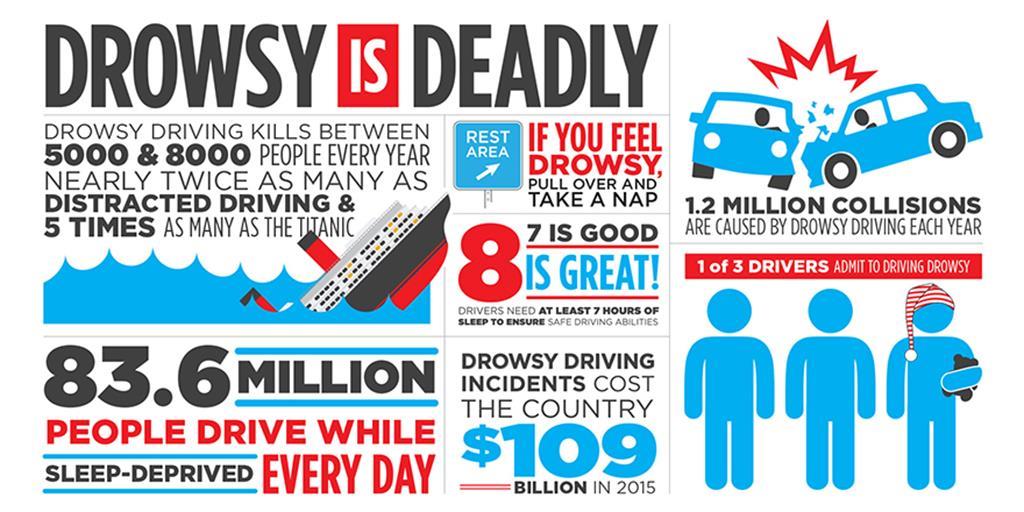
Transitioning back into standard time when we turn back our clocks in the fall may be easier than losing an hour of sleep in the spring, but it can still mess with our body's natural sleep cycle. So, as we allow our bodies to adjust, it's important to make sure we get plenty of sleep — especially before we get behind the wheel.
Did you know...
- Drowsy driving was responsible for 846 deaths in 2014, according to the National Highway Traffic Safety Administration.
- Going 21 hours without sleep mimics having a blood alcohol concentration of 0.08 percent (the legal limit in Pennsylvania).
- Fatigue-related fatal and injury crashes cost society around $109 billion per year — and that's not including property damage.

Sleep is the only remedy for drowsy driving. If you are behind the wheel and feeling tired, take a break! Rolling down the window, turning up the radio or AC, or drinking a caffeinated beverage is not enough to stave off drowsiness.
If you're planning a long trip, don't drive alone. Vehicles in which the driver is accompanied by a passenger are nearly 50 percent less likely to be involved in a drowsy-driving-related crash. If you must drive alone, schedule breaks every two hours or 100 miles to stretch and move around. And if you think you are too tired to drive, fine a safe, legal place off the roadway to take a nap.
Warning signs of drowsy driving include:
- Having trouble keeping your eyes open and focused
- The inability to keep your head up
- Daydreaming or having wandering, disconnected thoughts
- Drifting from your lane or off the road, or tailgating
- Yawning frequently or rubbing your eyes repeatedly
- Missing signs or driving past your intended turn or exit
- Feeling irritable or restless
- Being unable to remember how far you have traveled, or landmarks you have passed
Drowsy Driving Prevention Week is Nov. 5-12; learn more at the National Sleep Foundation’s website.
Follow PennDOT on social media — Facebook, Twitter, and Instagram.

ABOUT THIS BLOG
Did you know PennDOT is directly responsible for nearly 40,000 miles of highway and roughly 25,000 bridges? We oversee programs and policies affecting highways, urban and rural public transportation, airports, railroads, ports and waterways, in addition to administering the state's more than 11 million vehicle registrations and 8.8 million driver's licenses.
So, how do we do what we do? And how can we help you travel in Pennsylvania — whether it be for business or leisure — in safe and enjoyable manner? Read PennDOT Way to learn more about the department, what we do, and how and why we do it.
TAGS
50-Year Anniversary, 511PA, Aggressive Driving, Airports, Autonomous Vehicles, Bicycles, Bridges, Child Safety, Community Relations, Construction, COVID-19, Distracted Driving, District 1, District 10, District 11, District 12, District 2, District 3, District 4, District 5, District 6, District 8, District 9, DOTcom, Driver and Vehicle Services, Emergency Responders, Employment, Equity, FAQ Friday, Human Trafficking, Impaired Driving, Innovations, Live Free Ride Alive, Maintenance Monday, Motorcycles, Older Drivers, PA Motorcycle Safety Program, Pedestrians, PennDOT Connects, Ports, Public Transit, Railroads, REAL ID, Road MaP, Roadside Beautification, Rural Roads, Safety, School Buses, Seat Belts, State Transportation Innovation Council (STIC), Sustainability, Teen Drivers, Throwback Thursday, Transportation Funding, Travel in PA, Welcome Centers, Winter, Work Smart, Work Zone, Yellow Dot
LATEST POSTS
PennDOT Continues Sharing, Updating Resources for Local Governments to Pursue Bipartisan Infrastructure Law Funding Opportunities
Norwin High School Wins 2024 ‘Innovations Challenge’
Demo Complete: I-95 CAP Project in Center City Philadelphia
PennDOT Archeologist Connects Past, Present, and Future
Lehigh Valley DUI, Highway Safety Task Force Hosts Law Enforcement Seminar
ARCHIVES
2024
2023
2022
2021
2020
2019
2018
2017

